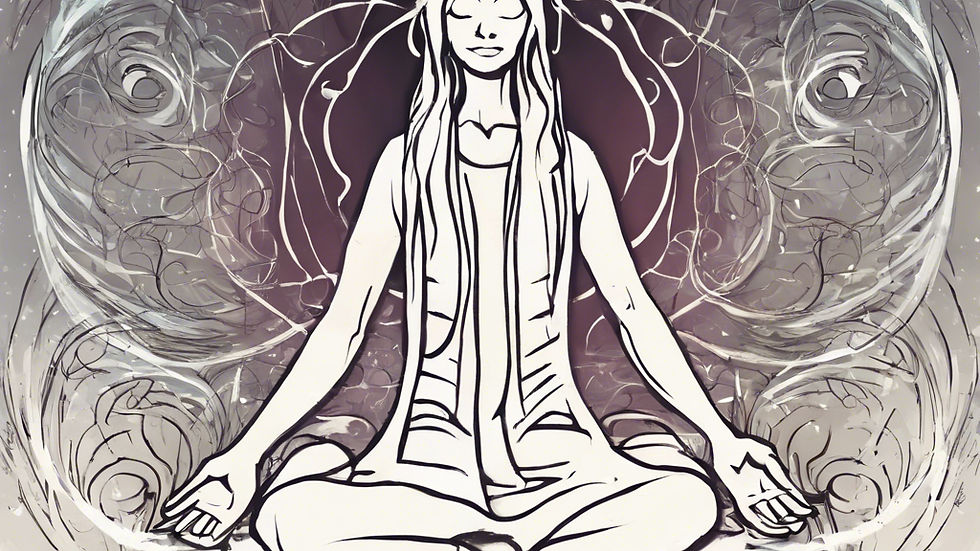Exploring the Transformative Journey of a Reiki Master
- Louise Claridge
- Apr 7
- 5 min read
Updated: Jun 17
Introduction to My Reiki Journey
From the moment I felt energy flowing through my palms, my life took a transformative turn. What began as a simple curiosity about alternative healing methods has evolved into a profound spiritual and professional path as a Reiki Master. Initially, I sought out a healing session because I preferred the option of not being physically touched. More about my journey here.
Today, I want to share insights from this journey. I will cover the challenges and revelations I faced and explore the deep fulfillment that comes from helping others heal through universal life force energy.
Understanding Reiki: A Healing Technique
Reiki, pronounced ray-key, is a Japanese energy healing technique. The term itself combines "Rei," meaning universal, and "ki," referring to life energy. As practitioners, we serve as conduits for this healing energy. It flows through our hands to promote balance, wellness, and natural healing in recipients.
Reiki operates on the principle that when our life force energy is low, we are more susceptible to stress and illness. Conversely, when energy flows freely, we experience greater health and happiness. What sets Reiki apart from other healing modalities is its non-invasive nature. It doesn’t require physical manipulation. Reiki works through gentle hands-on or off techniques, and it can even be performed from a distance.
The Path to Becoming a Reiki Master
The journey to becoming a Reiki Master unfolds across three traditional levels. Let's explore each one.
Level 1: Shoden (Beginning)
My foundation started with learning the history of Reiki, hand positions, and self-treatment techniques. The attunement process—where my teacher opened my energy channels—was both subtle and profound. I vividly remember the warmth of my hands, the heightened sounds surrounding me, and the tingling sensations confirming that something significant had shifted within me.
Level 2: Okuden (Inner Teaching)
During this level, I learned to use sacred symbols and mantras that amplified the Reiki energy. I also began practicing distance healing. Honestly, I was skeptical at first, but I soon found it fascinating. The realization that energy transcends physical space transformed my understanding of connection and healing.
Level 3: Shinpiden (Mystery Teaching) and Master Level
The master training deepened my spiritual connection and prepared me to attune others. Receiving the master symbol felt like being entrusted with something precious. It was a responsibility to carry this tradition forward with integrity, as I became part of a lineage of previous masters.
Living as a Reiki Master
People say that being a Reiki Master extends beyond the treatment room. It's a way of living that infuses every aspect of daily life. I can honestly say this is true.
My Daily Practice Routine

Each day typically begins with self-treatment. I would like to say I dedicate 20 minutes to center and ground myself before facing the world. However, my schedule often dictates otherwise, especially when I am rushing to get the kids ready for school! Despite this, I ensure I engage in self-treatment daily, whether it’s for 5 minutes or 20.
This consistent practice strengthens my connection to Reiki energy and enhances my capacity as a channel during client sessions.
Client Sessions: Unique and Transformative
Each client session is unique. Some individuals come to address specific physical ailments, while others seek emotional healing or spiritual growth. The beauty of Reiki is its holistic approach. It addresses the whole person, flowing wherever healing is needed most. I have witnessed remarkable transformations—chronic pain alleviated, anxiety calmed, and deep emotional releases achieved.
Teaching: Sharing Reiki Knowledge
Passing on Reiki knowledge through attunements and training is perhaps the most sacred aspect of my role as a Master. Watching students experience their first energy flow brings me back to my own beginnings. It renews my appreciation for this gift.
Facing Challenges and Misconceptions
This path hasn't been free of obstacles. Let's delve into some challenges Reiki practitioners face.
Overcoming Skepticism
In a world that values scientific proof, energy healing often encounters skepticism. I've learned to respect different perspectives while remaining confident in my personal experiences. The growing body of research on Reiki therapy is gradually bridging this gap.
Addressing Spiritual Bypassing
There is a common misconception that Reiki practitioners must constantly remain calm and rise above negative emotions. However, we experience a full range of human emotions. We simply have additional methods to manage them. Genuine healing involves acknowledging all emotions rather than avoiding them.
Establishing Healthy Boundaries
Working with energy requires strong boundaries. Learning how to release clients' energy after sessions and not taking on their problems was a crucial lesson in my personal development.
The Transformative Impact of Reiki
Becoming a Reiki Master has transformed me beyond my initial expectations.
Enhanced Intuition
Engaging in daily energy work has heightened my intuition. I can perceive subtle energetic shifts in myself and others. This awareness informs my practice and personal interactions.
Cultivating Presence
Reiki teaches the value of presence like no other practice. Being fully present with a client in pain or distress develops a muscle of awareness that translates to everyday life.
Deepening Compassion
Working with vulnerable individuals opens my heart. I have cultivated deeper compassion—not just for others, but also for myself. We are all works in progress.
Integrating Reiki with Modern Life
Reiki isn't separate from modern living. Instead, it enhances it in various ways.
Complementary Care in Healthcare
I emphasize that Reiki complements—rather than replaces—conventional medical treatment. Some of my most rewarding experiences have occurred in integrative settings, collaborating with healthcare professionals.
Workplace Wellness Initiatives
More organizations are recognizing the benefits of energy work for employee wellness. Brief Reiki sessions can significantly reduce workplace stress and increase productivity. I have developed corporate programs to introduce these concepts accessibly.
Self-Care in a Digital Age
In today's hyper-connected world, Reiki provides a way to disconnect and recharge. Teaching simple energy techniques for busy workdays has become an essential part of my practice.
Growing Your Own Reiki Practice
For those considering the Reiki path, here are some practical pointers:
Building Your Credentials
Beyond Reiki certification, consider complementary training in anatomy, ethics, or basic counseling. These expand your credibility and enhance your effectiveness.
Creating a Healing Space
Whether practicing from home or a studio, your space matters. It should feel safe, peaceful, and professional—a true sanctuary for healing.
Ethical Business Practices
Establishing clear policies regarding fees, cancellations, and scope of practice is essential. Transparency builds trust with clients.
Prioritizing Self-Care
You cannot pour from an empty cup. Regular self-treatment, supervision, or exchanges with fellow practitioners, and maintaining your own spiritual practice are crucial.
Conclusion: Embracing the Journey
Becoming a Reiki Master is a journey of continuous learning and growth. The more I practice, the more I recognize how much there is still to discover about this profound healing art. What remains constant is the privilege of witnessing healing unfold—sometimes in dramatic ways, often in quiet, subtle shifts that accumulate over time.
If you feel called to explore Reiki, whether as a recipient or a potential practitioner, I encourage you to approach it with an open heart and mind. This ancient wisdom has profound relevance in our modern times. It offers a path toward wholeness in a fragmented world.
I would love to hear about your experiences with energy healing in the comments below. Has Reiki touched your life? Are you curious to learn more?








Comments